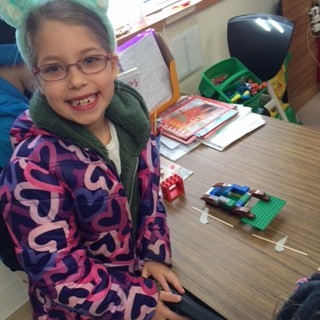January 25th – 29th
Happy Tu Bishvat! We began our week by studying trees, forestry, fruits, and plants in celebration of Tu Bishvat! Above, the students are making pictures to show how people are like trees.
Today, the students presented their Project Based Learning work that showed how goods get from the factory to the store. They learned that items can be made more efficiently on an assembly line. They created clown toys on an assembly line, and then they delivered the toys to a truck.
The truck (pictured above) delivered the goods to a train.
Then the train transported the toys to the airport.
The goods were then moved to a ship at the seaport.
Finally, the toys ended up on a truck and reached the store where customers can purchase them!
The students collaborated to create all of the different types of transportation in this process and they beautifully presented their learning to other classes and faculty members!
Reading
This week the students continued studying synonyms and antonyms. We also began working on making words into contractions. The students studied different rules for breaking words into syllables. We have learned that CVC words (or words that contain a consonant, vowel, consonant pattern) can be broken into two or more pieces using the CVC chunks. For example, the word letter can be broken into two syllables: let- ter. This trick helps us when reading unknown words! This week we learned how to break words apart right after the long vowel sound. For example, baby or tulip. You can break these words into ba-by and tu-lip. The students decided that when they read a word and it doesn’t sound like anything they recognize they can reread it and change the vowel sound!
Next week, we will read a nonfiction selection called Jellies and learn about jellyfish. The students will continue studying contractions, identifying facts and opinions, and learn how to monitor their reading to clarify meaning. Our vocabulary words are: Decide, disgusting, drift, millions, simple, wrapped, choices, and weaker.
Spelling
This week the students studied words ending in “k” and “ck.” We also studied how to add the suffixes “ed’ and “ing” to words ending in the letter “e.” The students learned that they need to drop the “e” at the end of the word before adding “ed” or “ing.” For example: skate becomes skated or skating. Next week, we will learn how to turn words into plurals by adding “s” and “es” and we will learn about the suffixes “er” and “est.”
Writing
The students are working on writing with “voice.” This unit requires the students to use exciting adjectives and verbs. We are hunting through our books for great words we can use in our own writing.
Math
We are working on solving addition and subtraction word problems. One of the big shifts in math from first to second grade is now the students are required to determine which operations their word problems are asking them to solve. The students are taught to look for the clues, or words like “altogether”, “more than”, and “how much was left?” These clues will help them know if it is time to add or subtract. We also say that, “Twice is Nice!” to help the students remember to read word problems more than once! Next week the students will work on subtraction problems that require regrouping.
Have a wonderful weekend!







